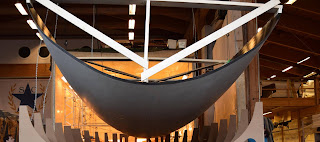These beautiful narrow yachts are a breath of fresh air in a yacht design panorama more and more dominated by very beamy boats. The fact that most of them are very beamy has nothing to do with sail performance, but with managing the biggest interior volume for a given size, and these days even cruiser-racers are becoming beamier and beamier.
Their shape has the advantage of being visually associated with solo racing sailboats, probably the most popular form of sail racing today, and their large beam allows not only that visual racing connotation, as it also provides a bigger interior.
They are also less expensive to build because beamy boats dispense a bigger B/D to sail relatively well (although not for having good safety stability and AVS) and that allows less reinforced hulls and a lighter keel structure.
Narrow sailboats have many disadvantages, they offer a much smaller interior for the length, in some marinas pay a lot more (for the same interior space), sail with more heel, need a bigger B/D but offer also an easily driven hull, that provides a way of sailing fast with smaller sails, better light wind performance and a sailing pleasure that is very different from the one that is experienced on a beamier sailboat, a very particular one, related to the one that was experienced in narrow classic era racers.
Some months ago, when I first saw Aspect 45's first drawings, I found them beautiful, but honestly thought the boat would never be built: it was too radical, too much a love affair, but guess what, I was wrong! Cheers to the Nordic sailors and designers that keep this tradition of beautiful narrow fast yachts alive.
 |
Swing keel |
The Shogun 50 has a lifting keel (draft from 3.5 to 2.0m), but the Aspect 45 has a 3.5m draft keel that can be folded or brought to intermediate positions, modifying the longitudinal CG to get the right balance for better performance on different wind directions, wind strength, and sail set up. That keel will also swing if the boat hits a submerged rock, absorbing the impact force and preventing or diminishing damages on the hull structure or on the keel.
The hull looks great and the transom is gorgeous. The only thing that raises some doubts is the Carbon/epoxy monolithic hull. Unusual in carbon boats or even in sportive sailboats (that normally use a sandwich hull). They say that they prefer to use a monolithic hull to allow more resistance in groundings with rocks, but due to the brittle characteristic of carbon when laminated in big thickness, I cannot see any advantage over a sandwich hull with Kevlar on the outer layer, in strategic places. Probably the real reason is cutting costs.
A single deep rudder is used, connected to a tiller (enough due to the small beam). A steering wheel is optional. The boat comes standard with 4 big electric 3 speed harken winches and has lots of operations that work with hydraulic assistance, they don't give much details but say:
The propulsion is one of the few electric engines systems that make sense to me, for extensive cruising use. In fact it is a hybrid system: "The hybrid engine consists of a 27hp 3-cylinder Lombardini diesel engine and a 15hp electric motor, a total of 42hp. The hybrid assembly has 2 modes – generator and hybrid operation. In generator mode, the batteries can be charged with around 7kW without the propeller connected. In hybrid mode, the boat can run on ...electricity (only) up to 6 knots, at higher speeds the diesel engine will automatically switch in. ... Everything is managed automatically just like a modern hybrid car".
 The yacht comes standard with a LiFePo4 battery pack, 48V / 10.5 kWh + 24V / 3.5 kWh. It offers a lot more unusual equipment standard, including hydraulic systems, swing keel, insulation with Aerogel, Electric ventilation, heating elements in the cabins, galley, and head (controlled by a central thermostat), two refrigerators in the galley, and on deck and cockpit, recessed EVA foam deck grip panels, electric heated seats for the helmsman, 4 big 3 speed Harken electric winches, carbon spars, including the partially removable bowsprit.
The yacht comes standard with a LiFePo4 battery pack, 48V / 10.5 kWh + 24V / 3.5 kWh. It offers a lot more unusual equipment standard, including hydraulic systems, swing keel, insulation with Aerogel, Electric ventilation, heating elements in the cabins, galley, and head (controlled by a central thermostat), two refrigerators in the galley, and on deck and cockpit, recessed EVA foam deck grip panels, electric heated seats for the helmsman, 4 big 3 speed Harken electric winches, carbon spars, including the partially removable bowsprit.From an initial mild interest in this boat, due to the very scarce information and the odd swing keel design (on the drawings - not profiled and with a much bigger width up than down), I become very curious about this yacht, that presents many and very interesting innovative solutions that can make a lot of sense...if they work well.
The ones responsible for the project and design are part of an eclectic group that includes the mentor, Rolf Tannergård. He was the one responsible for a previous Aspect 40 (2010) that was an ugly yacht, but one that proved to be fast and do well in racing. This time the design team is bigger and the Aspect 45 looks much better than the older 40 even if the looks of the boat are not as ambitious as the boat itself. Their ambition is to make the Aspect 45 faster than the Shogun 50! That would be difficult, being the Shogun 50 a bigger yacht. The Aspect 45 technical characteristics are awesome, but even if it comes only close, swing keel and all, it would be a blast.











No comments:
Post a Comment